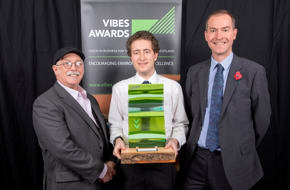Highlights
- Uses abandoned water infrastructure.
- Applied to a pump widely accepted and understood by communities.
- Low energy Usage.
- The installation procedure does not differ greatly from that of a standard Afridev, hence, very little extra knowledge is required to install and maintain.
- Majority of components can be found locally.

Benjamin McIntosh-Michaelis won the Hydro Nation Challenge with his designs of a unit, which can be fitted to the Afridev hand pump to allow the Afridev to fill a water tower. This unit is called the Afridev Hi-Lift (AHL). The AHL can be retrofitted to existing Afridev installations to give them the capability to lift water to an overhead tank and utilise previously abandoned water infrastructure. The Afridev Hi-Lift (AHL) can be implemented anywhere the Afridev is used, this includes most of Africa, parts of Asia and South America.
The Hydronation Challenge in conjunction with WaterAid, Scottish Government and the Hydronation Water Innovation Service was open to Scottish businesses, public sector and academia. The challenge was to put forward an idea or product to solve a real life Water, Sanitation or Hygiene problem that would help WaterAids’ work in Zambia.
The project was created to lift water from the Malawi Government Standard Pump, the Afridev, so it could be used to recover the abandoned water infrastructure across Malawi. The Afridev pump existing design was not able to lift water into the overhead tanks installed with the Playpumps, so Benjamin McIntosh-Michaelis, with support from academia and an International Development focussed student society, designed a module which can be retrofitted to existing Afridev pumps and be installed on new pump installations. This module allows water to be pumped to a head by pumping water into a sealed chamber where the hydrostatic pressure can build up to maintain the head required as water flows into an overhead tank.
This module is designed to use existing Water Resource Infrastructure Investment, and be installed on a pump already widely accepted and understood by communities. This module also matches the Afridev’s low energy usage as the user will operate the adapted pump in exactly the same way as a nonadapted pump. The installation procedure does not differ greatly from that of a standard Afridev, hence, very little extra knowledge is required to install and maintain. The majority of components are also made from the same stock materials as the Afridev using the same methods. As such the module has a similar lifespan to the Afridev which operates for a number of decades. The installation of these modules piggy backs the network which is well established for the Afridev pump, and the simplicity of the design aids in this by making the components cheap, simple and easy to replace if required.
The judges were impressed with the quality of the application. It was apparent that the entry could be used effectively within the development context and measures well against WaterAid’s criteria of:
- Availability in local markets
- Availability of spare parts or materials in local markets
- Ability to deliver cost effective, long-term supplies without complex maintenance, expensive components or expensive chemicals
Ben McIntosh-Michaelis, said: "Winning the Hydro Nation challenge award is incredibly beneficial for promoting the Adapted Afridev designs, and will help in progressing the project in the future. It is also significant for all the activities and participants engaged in the Climate Justice Fund (CJF). This is lead by Bob Kalin at the University of Strathclyde and the Malawian Government, alongside Water for People and EssEss Enterprises in Malawi. The award raises the profile of the CJF and shows that the objectives and outcomes are/have significant potential to
be beneficial.
“Personally, this award will have a huge positive impact on my career once I graduate, particularly as I am hoping to work as an engineer on similar projects within the International Development and Humanitarian Sectors. It is also reassuring to know that what I have been working on for the last four years or so is considered to be useful."